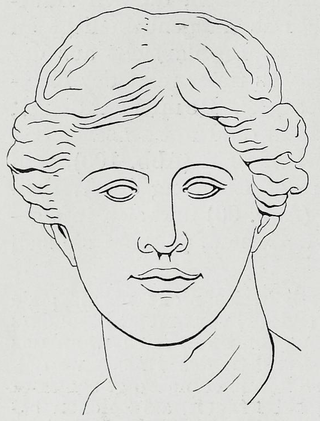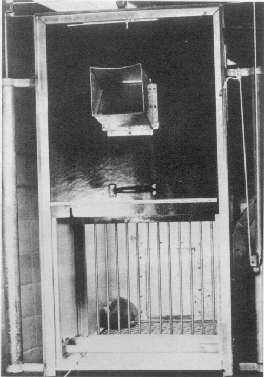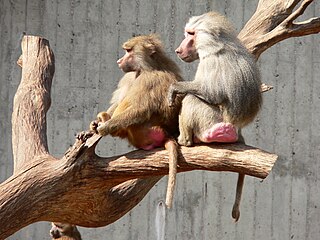James W. Prescott is an American developmental psychologist, whose research focused on the origins of violence, particularly as it relates to a lack of mother-child bonding.

Asymmetry is the absence of, or a violation of, symmetry. Symmetry is an important property of both physical and abstract systems and it may be displayed in precise terms or in more aesthetic terms. The absence of or violation of symmetry that are either expected or desired can have important consequences for a system.

The rhesus macaque, colloquially rhesus monkey, is a species of Old World monkey. There are between six and nine recognised subspecies that are split between two groups, the Chinese-derived and the Indian-derived. Generally brown or grey in colour, it is 47–53 cm (19–21 in) in length with a 20.7–22.9 cm (8.1–9.0 in) tail and weighs 5.3–7.7 kg (12–17 lb). It is native to South, Central, and Southeast Asia and has the widest geographic range of all non-human primates, occupying a great diversity of altitudes and a great variety of habitats, from grasslands to arid and forested areas, but also close to human settlements. Feral colonies are found in the United States, thought to be either released by humans or escapees after hurricanes destroyed zoo and wildlife park facilities.

Harry Frederick Harlow was an American psychologist best known for his maternal-separation, dependency needs, and social isolation experiments on rhesus monkeys, which manifested the importance of caregiving and companionship to social and cognitive development. He conducted most of his research at the University of Wisconsin–Madison, where humanistic psychologist Abraham Maslow worked with him for a short period of time.

Symmetry in biology refers to the symmetry observed in organisms, including plants, animals, fungi, and bacteria. External symmetry can be easily seen by just looking at an organism. For example, the face of a human being has a plane of symmetry down its centre, or a pine cone displays a clear symmetrical spiral pattern. Internal features can also show symmetry, for example the tubes in the human body which are cylindrical and have several planes of symmetry.

Facial symmetry is one specific measure of bodily symmetry. Along with traits such as averageness and youthfulness, it influences judgments of aesthetic traits of physical attractiveness and beauty. For instance, in mate selection, people have been shown to have a preference for symmetry.

Fluctuating asymmetry (FA), is a form of biological asymmetry, along with anti-symmetry and direction asymmetry. Fluctuating asymmetry refers to small, random deviations away from perfect bilateral symmetry. This deviation from perfection is thought to reflect the genetic and environmental pressures experienced throughout development, with greater pressures resulting in higher levels of asymmetry. Examples of FA in the human body include unequal sizes (asymmetry) of bilateral features in the face and body, such as left and right eyes, ears, wrists, breasts, testicles, and thighs.

The bonnet macaque, also known as zati, is a species of macaque endemic to southern India. Its distribution is limited by the Indian Ocean on three sides and the Godavari and Tapti Rivers, along with its related competitor the rhesus macaque in the north. Land use changes in the last few decades have resulted in changes in its distribution boundaries with the rhesus macaque, raising concern for its status in the wild.

The pit of despair was a name used by American comparative psychologist Harry Harlow for a device he designed, technically called a vertical chamber apparatus, that he used in experiments on rhesus macaque monkeys at the University of Wisconsin–Madison in the 1970s. The aim of the research was to produce an animal model of depression. Researcher Stephen Suomi described the device as "little more than a stainless-steel trough with sides that sloped to a rounded bottom":
A 3⁄8 in. wire mesh floor 1 in. above the bottom of the chamber allowed waste material to drop through the drain and out of holes drilled in the stainless-steel. The chamber was equipped with a food box and a water-bottle holder, and was covered with a pyramid top [removed in the accompanying photograph], designed to discourage incarcerated subjects from hanging from the upper part of the chamber.
The field of psychology has been greatly influenced by the study of genetics. Decades of research have demonstrated that both genetic and environmental factors play a role in a variety of behaviors in humans and animals. The genetic basis of aggression, however, remains poorly understood. Aggression is a multi-dimensional concept, but it can be generally defined as behavior that inflicts pain or harm on another.
Stephen J. Suomi is chief of the Laboratory of Comparative Ethology at the National Institute of Child Health and Human Development (NICHD) in Bethesda, Maryland. He is also a research professor at the University of Virginia, the University of Maryland, and Johns Hopkins University. He is involved with the Experience-based Brain & Biological Development Program, launched in 2003 by the Canadian Institute for Advanced Research.

Sexual dimorphism describes the morphological, physiological, and behavioral differences between males and females of the same species. Most primates are sexually dimorphic for different biological characteristics, such as body size, canine tooth size, craniofacial structure, skeletal dimensions, pelage color and markings, and vocalization. However, such sex differences are primarily limited to the anthropoid primates; most of the strepsirrhine primates and tarsiers are monomorphic.
Socialization of animals is the process of training animals so that they can be kept in close relationship to humans.
Odour is sensory stimulation of the olfactory membrane of the nose by a group of molecules. Certain body odours are connected to human sexual attraction. Humans can make use of body odour subconsciously to identify whether a potential mate will pass on favourable traits to their offspring. Body odour may provide significant cues about the genetic quality, health and reproductive success of a potential mate.

Abnormal behavior of birds in captivity has been found to occur among both domesticated and wild birds. Abnormal behavior can be defined in several ways. Statistically, 'abnormal' is when the occurrence, frequency or intensity of a behaviour varies statistically significantly, either more or less, from the normal value. This means that theoretically, almost any behaviour could become 'abnormal' in an individual. Less formally, 'abnormal' includes any activity judged to be outside the normal behaviour pattern for captive birds of that particular class or age. For example, running rather than flying may be a normal behaviour and regularly observed in one species, however, in another species it might be normal but becomes 'abnormal' if it reaches a high frequency, or in another species it is rarely observed and any incidence is considered 'abnormal'. This article does not include 'one-off' behaviours performed by individual birds that might be considered abnormal for that individual, unless these are performed repeatedly by other individuals in the species and are recognised as part of the ethogram of that species.
Social-emotional agnosia, also known as emotional agnosia or expressive agnosia, is the inability to perceive facial expressions, body language, and voice intonation. A person with this disorder is unable to non-verbally perceive others' emotions in social situations, limiting normal social interactions. The condition causes a functional blindness to subtle non-verbal social-emotional cues in voice, gesture, and facial expression. People with this form of agnosia have difficulty in determining and identifying the motivational and emotional significance of external social events, and may appear emotionless or agnostic. Symptoms of this agnosia can vary depending on the area of the brain affected. Social-emotional agnosia often occurs in individuals with schizophrenia and autism. It is difficult to distinguish from, and has been found to co-occur with, alexithymia.
Mate preferences in humans refers to why one human chooses or chooses not to mate with another human and their reasoning why. Men and women have been observed having different criteria as what makes a good or ideal mate. A potential mate's socioeconomic status has also been seen important, especially in developing areas where social status is more emphasized.

Animal non-reproductive sexual behavior encompasses sexual activities that non-human animals participate in which do not lead to the reproduction of the species. Although procreation continues to be the primary explanation for sexual behavior in animals, recent observations on animal behavior have given alternative reasons for the engagement in sexual activities by animals. Animals have been observed to engage in sex for social interaction bonding, exchange for significant materials, affection, mentorship pairings, sexual enjoyment, or as demonstration of social rank. Observed non-procreative sexual activities include non-copulatory mounting, oral sex, genital stimulation, anal stimulation, interspecies mating, and acts of affection, although it is doubted that they have done this since the beginning of their existence. There have also been observations of sex with cub participants, same-sex sexual interaction, as well as sex with dead animals.

Neoteny in humans is the retention of juvenile traits well into adulthood. This trend is greatly amplified in humans especially when compared to non-human primates. Neotenic features of the head include the globular skull; thinness of skull bones; the reduction of the brow ridge; the large brain; the flattened and broadened face; the hairless face; hair on the head; larger eyes; ear shape; small nose; small teeth; and the small maxilla and mandible.
The Wisconsin National Primate Research Center (WNPRC) is a federally funded biomedical research facility located at the University of Wisconsin-Madison. The WNPRC is part of a network of seven National Primate Research Centers which conduct biomedical research on primates. As of 2020, the center houses approximately 1,600 animals.












